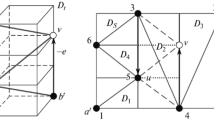Abstract
We establish a correspondence between the singular values of a transfer matrix evaluated along the imaginary axis and the imaginary eigenvalues of a related Hamiltonian matrix. We give a simple linear algebraic proof, and also a more intuitive explanation based on a certain indefinite quadratic optimal control problem. This result yields a simple bisection algorithm to compute the H∞ norm of a transfer matrix. The bisection method is far more efficient than algorithms which involve a search over frequencies, and the usual problems associated with such methods (such as determining how fine the search should be) do not arise. The method is readily extended to compute other quantities of system-theoretic interest, for instance, the minimum dissipation of a transfer matrix. A variation of the method can be used to solve the H∞ Armijo line-search problem with no more computation than is required to compute a single H∞ norm.
Similar content being viewed by others
References
B. D. O. Anderson, An algebraic solution to the spectral factorization problem,IEEE Trans. Automat. Control,12 (1967), 410–414.
S. Barnett and D. D. Siljak, Routh’s algorithm: a centennial survey,SIAM Rev.,19 (1977), 472–489.
S. Boyd and J. Doyle, Comparison of peak and RMS gains for discrete-time systems,Systems Control Lett.,9 (1987), 1–6.
R. Byers, A HamiltonianQR algorithm,SIAM J. Sci. Statist. Comput.,7 (1986), 212–229.
R. Byers, A Bisection Algorithm for Measuring the Distance of a Stable Matrix to the Unstable Matrices, Technical Report, North Carolina State University at Raleigh, 1987; to appear inSIAM J. Sci. Statist. Comput.
C. A. Desoer and M. Vidyasagar,Feedback Systems: Input-Output Properties, Academic Press, New York, 1975.
D. F. Enns, Model reduction with balanced realizations: an error bound and a frequency weighted generalization,Proceedings of the 23rd IEEE Conference on Decision and Control, Las Vegas, NV, 1984, pp. 127–132.
B. A. Francis,A Course in H ∞ Control Theory, Lecture Notes in Control and Information Sciences, Vol. 88, Springer-Verlag, New York, 1987.
K. Glover, All optimal Hankel-norm approximations of linear multivariable systems and theirL ∞-error bounds,Internat. J. Control,39 (1984), 1115–1193.
G. H. Golub, S. Nash, and C. Van Loan, A Hessenberg-Schur method for the matrix problemAX+XB=C, IEEE Trans. Automat. Control,24 (1979), 909–913.
G. H. Golub and C. F. Van Loan,Matrix Computations, Johns Hopkins University Press, Baltimore, MD, 1983.
P. Henrici,Applied and Computational Complex Analysis, Vol. 1, Wiley-Interscience, New York, 1978.
T. Kailath,Linear Systems, Prentice-Hall, Englewood Cliffs, NJ, 1980.
A. J. Laub, Efficient calculation of frequency response matrices from state space models,ACM Trans. Math. Software,12 (1986), 26–33.
D. G. Luenberger,Linear and Nonlinear Programming, 2nd edn., Addison-Wesley, Reading, MA, 1984.
C. F. Van Loan, A symplectic method for approximating all eigenvalues of a Hamiltonian matrix,Linear Algebra Appl.,61 (1984), 233–251.
C. F. Van Loan, How near is a stable matrix to an unstable one?Contemp. Math.,47 (1985), 465–478.
M. Vidyasagar,Control System Synthesis: A Factorization Approach, MIT Press, Cambridge, MA, 1985.
J. C. Willems, Least squares stationary optimal control and the algebraic Riccati equation,IEEE Trans. Automat. Control,16 (1971), 621–634.
G. Zames and B. A. Francis, Feedback, minimax sensitivity, and optimal robustness,IEEE Trans. Automat. Control,28 (1983), 585–601.
Author information
Authors and Affiliations
Additional information
Research supported in part by NSF under Grant ECS-85-52465, ONR under Grant N00014-86-K-0112, an IBM faculty development award, and Bell Communications Research.
Rights and permissions
About this article
Cite this article
Boyd, S., Balakrishnan, V. & Kabamba, P. A bisection method for computing the H∞ norm of a transfer matrix and related problems. Math. Control Signal Systems 2, 207–219 (1989). https://doi.org/10.1007/BF02551385
Received:
Revised:
Issue Date:
DOI: https://doi.org/10.1007/BF02551385




